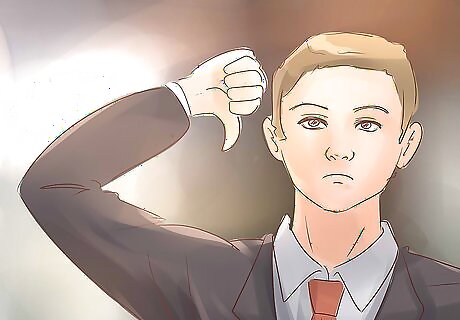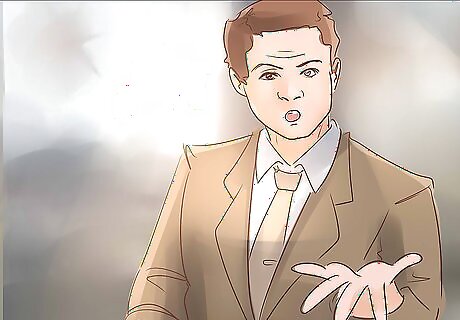
views
Determining Whether You Can Terminate an Employee

Decide whether a lay-off or a firing is most appropriate. When you are making a termination decision, one of the first things you will consider is whether it might be a lay-off or a firing. Using the following information, decide which option is right for you: A lay-off is a termination of an employee where the position they held will not be re-filled and will instead be eliminated. This most often happens when the employer needs to downsize and eliminate one or more parts of their workforce in order to reduce overhead costs. If you think a lay-off might be the best option, you will have to determine which employee or group of employees should be terminated. As an employer, you must be careful to base your decisions on sound business related criteria, policies, and practices. Be careful not to base your decision on age, race, national origin, religion, gender, physical disability, or sexual orientation. On the other hand, a firing is most often triggered by an employee's poor job performance. Unlike a lay-off, when you fire an employee, another employee is hired to replace them. The rest of this article will discuss how to terminate an employee when you decide it is going to be a firing.

Consider the general rule. California is an "at-will" employment state, which means the law presumes an employer can hire or fire an employee whenever they want for almost any reason or even no reason at all. While this is the general rule, there are quite a few exceptions. Look below to determine if any exceptions apply to your situation.

Determine if there is a contract involved. Some employees have written employment contracts, or are part of a union where a collective bargaining agreement has been implemented, and those agreements specify how and why an employee can be terminated. If an employee has an employment contract, you must consult it and follow the rules laid out before serving the termination letter. Oftentimes an employment contract will state an employee can only be terminated by a vote of the board of directors, for good cause, or for some other specific reason and cannot terminate their employment at will. If an employee/employer relationship is governed by a collective bargaining agreement, that agreement will control the questions about how and when an employee can be terminated.

Look through any company policies and documents. If your company has an employee handbook or company policy that includes limitations on your right to terminate employees, those policies and documents must be consulted and followed. Some common employment policies include: Employment at-will policies. This type of policy simply tells every employee that their employment is at-will and that termination may occur for any reason, including no reason at all. If you have this type of policy, make sure every employee knows about it when they are hired. Progressive discipline policies. These types of policies usually include established discipline that starts with written warnings and ends with termination. If you have one of these policies, make sure you followed each progressive step in the discipline process (e.g., make sure you give them a written warning before terminating them). Also, make sure you document all discipline and keep it as evidence in case a terminated employee files a lawsuit. Internal dispute resolution or arbitration policies. If you have a policy of giving employees an opportunity to go through certain internal systems before being terminated, be sure you give an employee a fair chance to go through those policies before you terminate them. Termination policies requiring "just cause". Some employers have a policy of only terminating employees when there is "just cause." In California, this usually means an employee must have violated some statute or policy in order to be terminated.

Determine if any state and/or federal laws will apply. When contemplating an employee's termination, it will be important that you understand a number of laws that protect certain classes of employees. Before terminating an employee, determine whether any of the following laws may apply: Americans with Disabilities Act. If an employee is physically or mentally disabled, you must make attempts to reasonably accommodate that employee's disability. If you have, make sure you document the attempts you made. Title VII / California's Fair Employment and Housing Act. When deciding to terminate an employee, you must make sure that employee is being treated in the same manner as other employees in similar circumstances. For example, did other employees have more chances before being terminated for the same reason as this employee and if so, is there must be a legitimate reason why. Pregnancy. If an employee is pregnant, they are entitled to four months of leave for pregnancy-related disabilities. Workers' Compensation. It may be considered workers' compensation discrimination if you terminate an employee who has filed a workers' compensation claim. Retaliation. An employee cannot be terminated for reporting an illegal activity of the company or for participating in an investigation of the company. Discrimination Laws. You cannot terminate an employee on the basis of age, race, national origin, religion, gender, physical disability, sexual orientation, or a number of other reasons.

Consider the legal ramifications of not terminating an employee. Just as there can be legal ramifications for terminating an employee, there can also be legal ramifications for failing to terminate an employee when you should have. For example, if an employee has been violent, threatened violence, or has sexually harassed other employees, it may be legally necessary to terminate that employee.

Review an employee's personnel file. Before making the final decision to terminate an employee, look through their personnel file and make sure you have sufficient documentation to back up the reasons you are terminating the employee. Look for anything in the employee's file that might be evidence of an illegal termination (e.g., a letter stating that the reason an employee is late so often is because she is pregnant). If you find any concerning information, consult someone else, including an attorney, before terminating the employee.
Completing the Termination

Use care when terminating an employee. Once you have determined that you are going to terminate an employee, you will have to sit down with that employee and break the bad news. When you do this, state the reason for their termination with great care and empathy. Your discussion should be short and to the point. The more you say, the more questions the employee is likely to have. Consider saying "it is no longer in the best interest of the company to continue the employment relationship."

Terminate the employee at the right time. Choose a good time for you and the employee to break the bad news. There is no clear rule on this and there are multiple schools of thought. One option is to terminate the employee on a Friday. Some people say this gives the employee a few days to digest the information and to cool off. It will also reduce the risk of an employee returning to work the next day and disrupting things. Another option is to terminate an employee early in the week. Some say this gives the employee an opportunity to quickly transition into looking for a new job, apply for unemployment benefits, and other necessary arrangements as soon as possible.

Make available an employee's final paycheck. Have the employee's final paycheck available and ready at the termination meeting. All outstanding money that is owed to the employee must be paid immediately upon termination.

Consider a severance pay agreement. If you wish, you can offer the employee additional compensation for the employee's promise to waive any right they have to bring a lawsuit against you for anything related to the termination.

Ask an employee to return any company property. Finally, before the termination meeting is over, ask the employee to return any company property they may have in their possession. This might include physical property such as books or notes, or it might include digital property such as computer passwords.




















Comments
0 comment